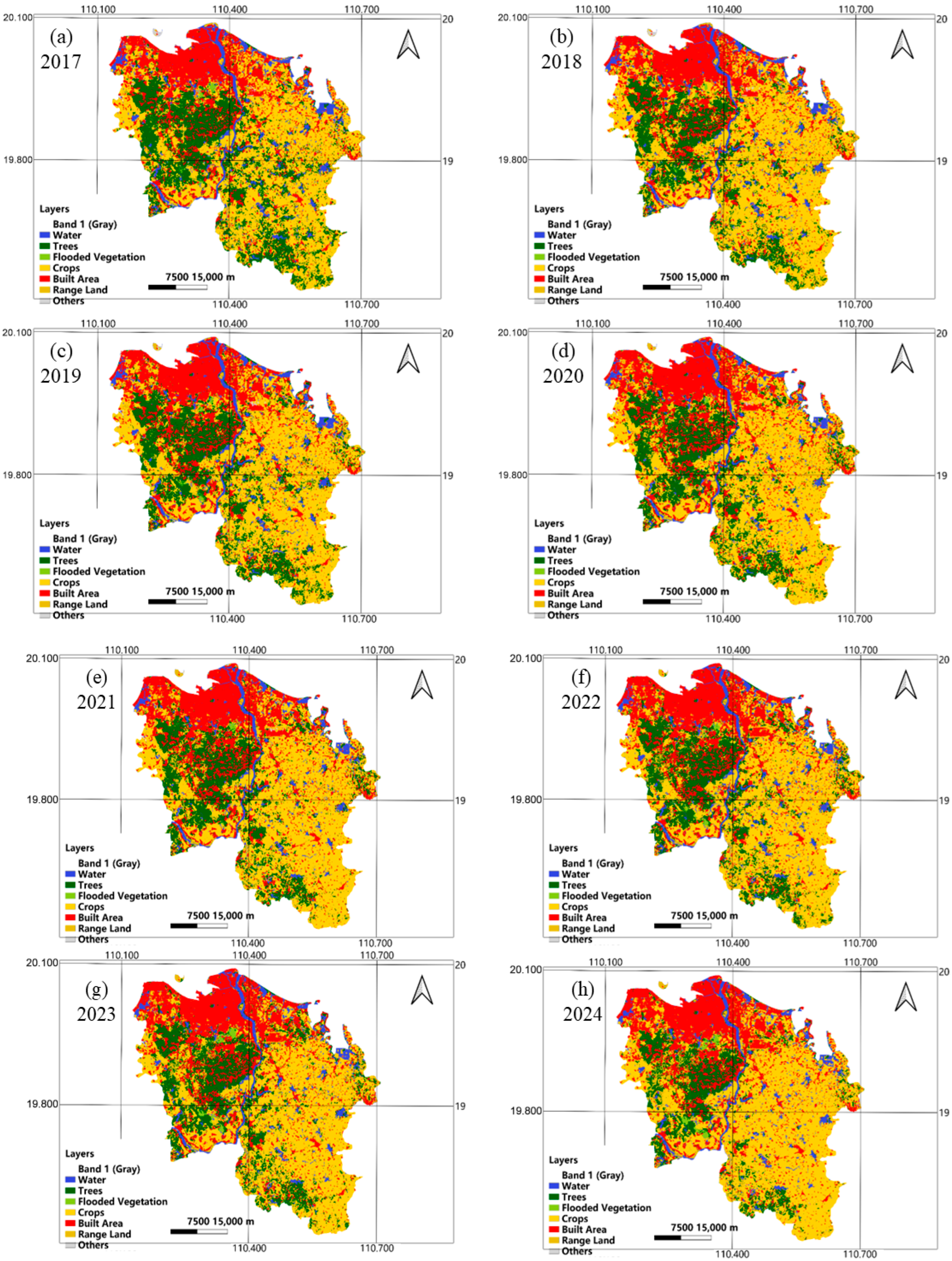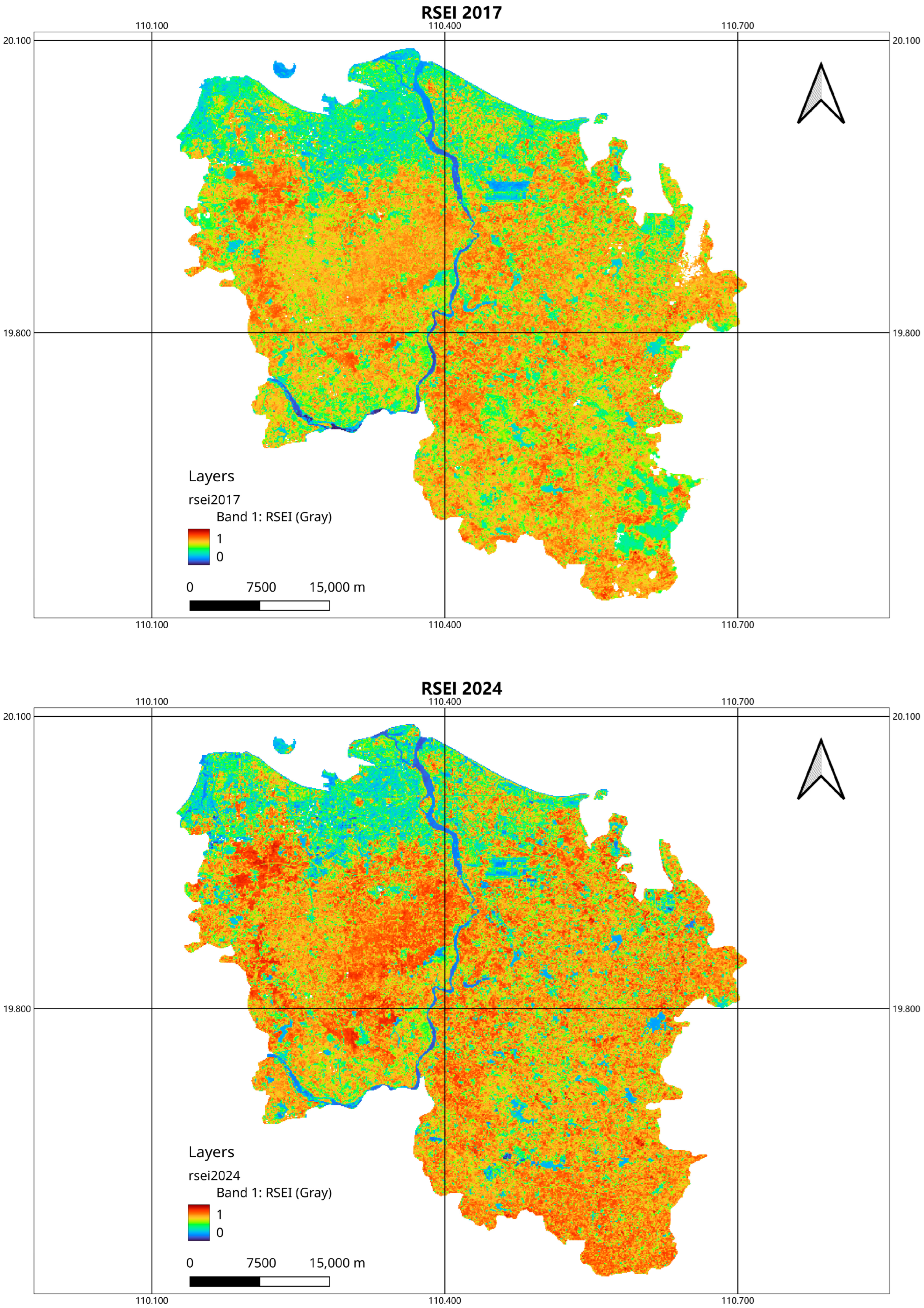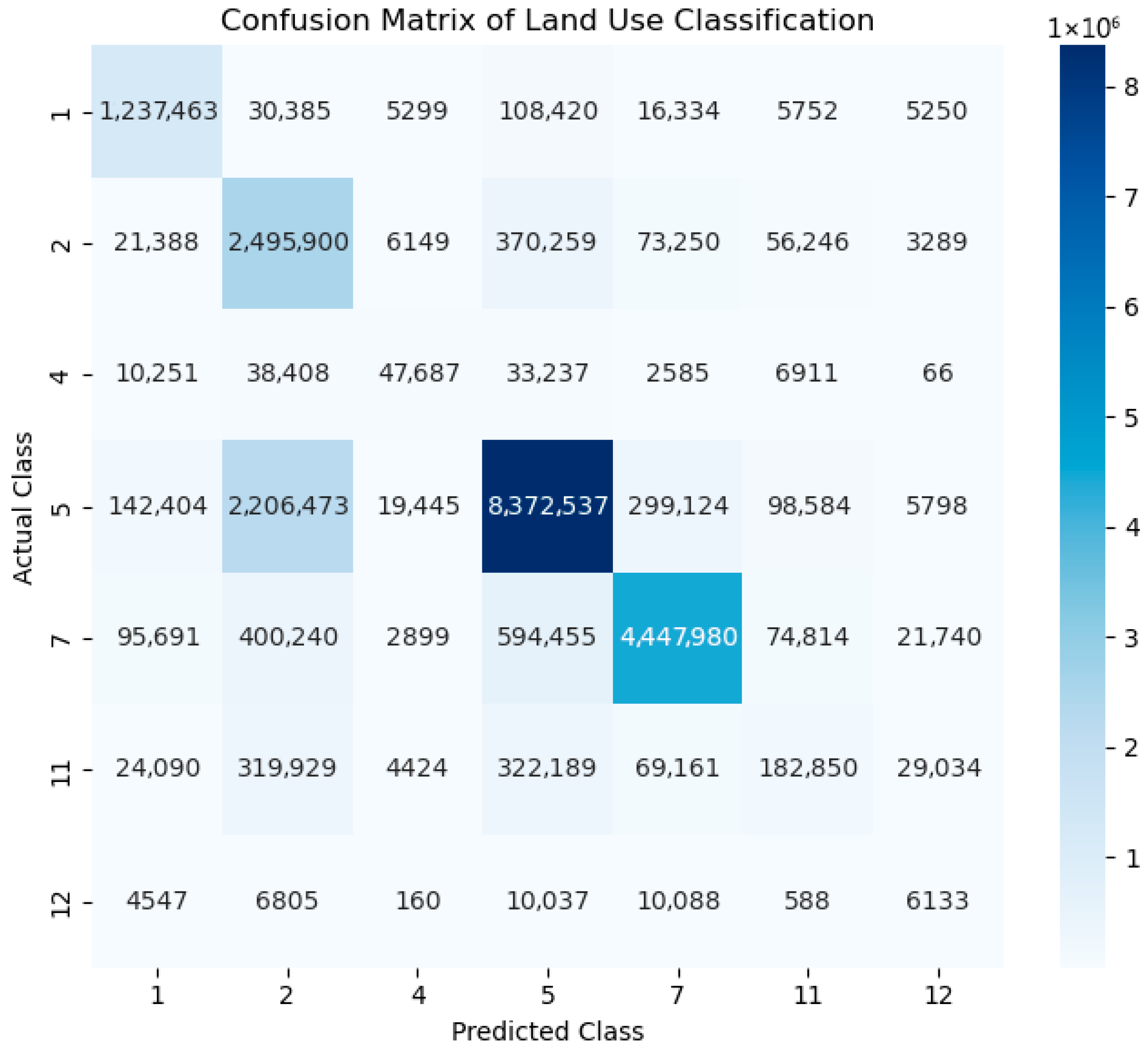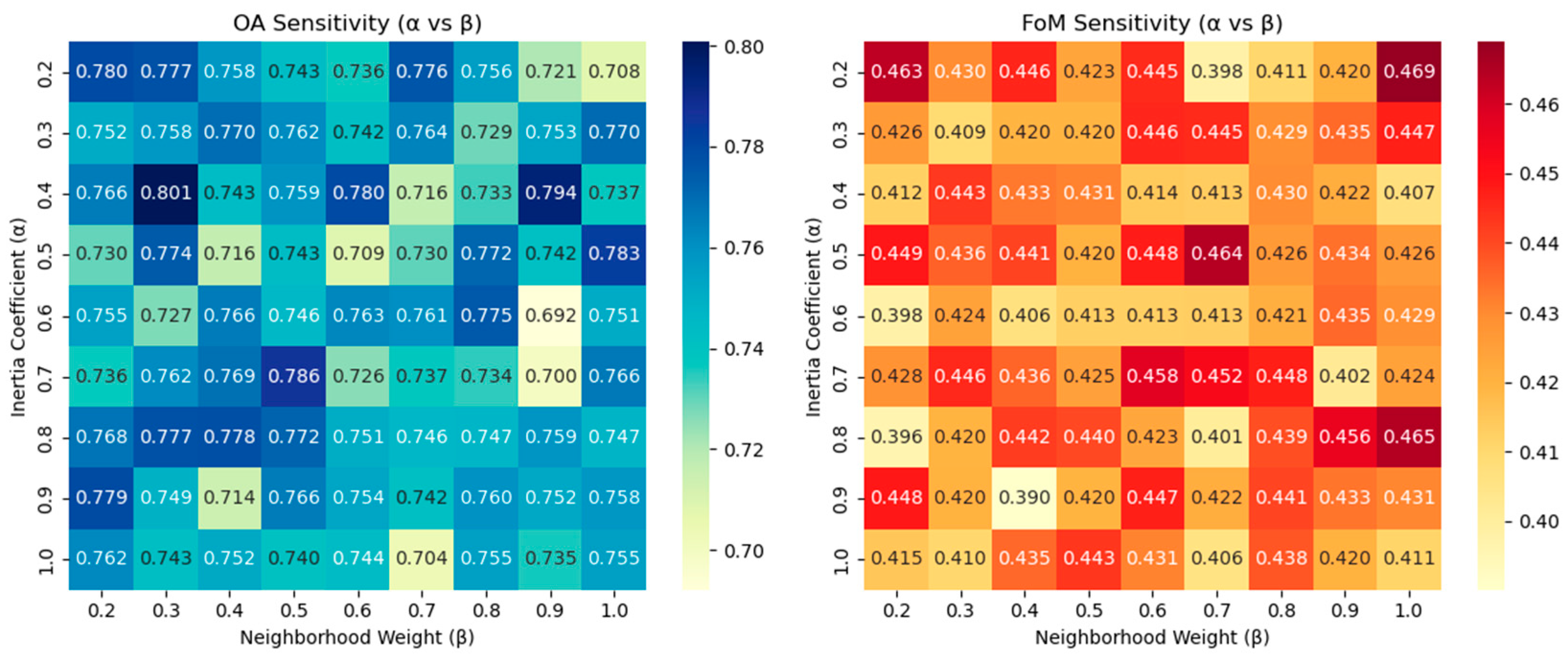Study on RSEI Changes Using Remote Sensing and Markov-FLUS Modeling Approach
Abstract
1. Introduction
2. Study Area and Materials
2.1. Study Area
2.2. Datasets and Materials
3. Methodology
3.1. LULC Classification and Change Dynamics
3.2. Comprehensive Index of Land Use Intensity
3.3. Construction of Remote Sensing Ecological Index
3.4. Markov-Plus Module and Driving Factors
- (1)
- Markov Model and Transition Probability Matrix Construction
- (2)
- FLUS Model Parameterization
- (3)
- Driving Factors and Model Calibration
- (4)
- Coupling with RSEI Evaluation
4. Results
4.1. Spatiotemporal Dynamics of Land Use in Haikou City
4.2. Land Use Transition Matrix
4.3. Land Use Intensity Comprehensive Index
4.4. Evaluation of Ecological Environment Quality in Haikou City
4.4.1. Results of the RESI Model
4.4.2. Dynamic Changes in Ecological Environment Status
4.5. Land Use Simulation Results
- (1)
- A complete confusion matrix was added to present the classification performance of each land-use category.
- (2)
- Class-wise UA and PA values were provided to evaluate the spatial prediction reliability of each category, as shown in Table 8.
- (3)
- A sensitivity analysis was conducted on key FLUS model parameters, including the inertia coefficient and neighborhood weights, to assess their effects on simulation accuracy.
5. Analysis and Discussion
5.1. Analysis of Land Use Changes in Haikou City
5.2. Discussion of Changes in RSEI in Haikou
5.3. Comparison with Related Studies
6. Conclusions
Author Contributions
Funding
Institutional Review Board Statement
Informed Consent Statement
Data Availability Statement
Acknowledgments
Conflicts of Interest
References
- Wang, Q.; Wang, H. Spatiotemporal dynamics and evolution relationships between land-use/land cover change and landscape pattern in response to rapid urban sprawl process: A case study in Wuhan, China. Ecol. Eng. 2022, 182, 106716. [Google Scholar] [CrossRef]
- Bajocco, S.; De Angelis, A.; Perini, L.; Ferrare, A.; Salvati, L. The impact of land use/land cover changes on land degradation dynamics: A Mediterranean case study. Environ. Manag. 2012, 49, 980–989. [Google Scholar] [CrossRef]
- Zhu, C.; Zhang, X.; Zhou, M.; He, S.; Gan, M.; Yang, L.; Wang, K. Impacts of urbanization and landscape pattern on habitat quality using OLS and GWR models in Hangzhou, China. Ecol. Indic. 2020, 117, 106654. [Google Scholar] [CrossRef]
- Zhang, R.; Zhang, X.; Yang, J.; Yuan, H. Wetland ecosystem stability evaluation by using Analytical Hierarchy Process (AHP) approach in Yinchuan Plain, China. Math. Comput. Model. 2013, 57, 366–374. [Google Scholar] [CrossRef]
- Wang, Y.; Ding, Q.; Zhuang, D. An eco-city evaluation method based on spatial analysis technology: A case study of Jiangsu Province, China. Ecol. Indic. 2015, 58, 37–46. [Google Scholar] [CrossRef]
- Özçelik, F.; Öztürk, B.A. Evaluation of Banks’ Sustainability Performance in Turkey with Grey Relational Analysis. J. Account. Financ. 2014, 63, 189–208. [Google Scholar]
- Pettorelli, N.; Vik, J.O.; Mysterud, A.; Gaillard, J.; Tucker, C.; Stenseth, N.C. Using the satellite-derived NDVI to assess ecological responses to environmental change. Trends Ecol. Evol. 2005, 20, 503–510. [Google Scholar] [CrossRef]
- Hu, Y.; Xu, E.; Kim, G.; Liu, C.; Tian, G. Response of spatio-temporal differentiation characteristics of habitat quality to land surface temperature in a fast urbanized city. Forests 2021, 12, 1668. [Google Scholar] [CrossRef]
- Xu, H.Q. A remote sensing urban ecological index and its application. Acta Ecol. Sin. 2013, 33, 7853–7862. [Google Scholar]
- Wu, L.; Yang, Y.; Xie, B. Modeling Analysis on Coupling Mechanisms of Mountain–Basin Human–Land Systems: Take Yuxi City as an Example. Land 2022, 11, 1068. [Google Scholar] [CrossRef]
- Cabral, P.; Feger, C.; Levrel, H.; Chambolle, M.; Basque, D. Assessing the impact of land-cover changes on ecosystem services: A first step toward integrative planning in Bordeaux, France. Ecosyst. Serv. 2016, 22, 318–327. [Google Scholar] [CrossRef]
- Meneses, B.M.; Reis, E.; Pereira, S.; Maria, J.V.; Reis, R. Understanding driving forces and implications associated with the land use and land cover changes in Portugal. Sustainability 2017, 9, 351. [Google Scholar] [CrossRef]
- Fang, Z.; Ding, T.; Chen, J.; Xue, S.; Zhou, Q.; Wang, Y.; Wang, Y.; Huang, Z.; Yang, S. Impacts of land use/land cover changes on ecosystem services in ecologically fragile regions. Sci. Total Environ. 2022, 831, 154967. [Google Scholar] [CrossRef] [PubMed]
- Tan, J.; Yu, D.; Li, Q.; Tan, X.; Zhou, W. Spatial relationship between land-use/land-cover change and land surface temperature in the Dongting Lake area, China. Sci. Rep. 2020, 10, 9245. [Google Scholar] [CrossRef]
- Zhang, Z.; Li, X.; Liu, X.; Zhao, K. Dynamic simulation and projection of land use change using system dynamics model in the Chinese Tianshan mountainous region, central Asia. Ecol. Model. 2024, 487, 110564. [Google Scholar] [CrossRef]
- Waiyasusri, K.; Yumuang, S.; Chotpantarat, S. Monitoring and predicting land use changes in the Huai Thap Salao Watershed area, Uthaithani Province, Thailand, using the CLUE-s model. Environ. Earth Sci. 2016, 75, 533. [Google Scholar] [CrossRef]
- Clarke, K.C.; Johnson, J.M. Calibrating SLEUTH with big data: Projecting California’s land use to 2100. Comput. Environ. Urban Syst. 2020, 83, 101525. [Google Scholar] [CrossRef]
- Tong, X.; Feng, Y. A review of assessment methods for cellular automata models of land-use change and urban growth. Int. J. Geogr. Inf. Sci. 2020, 34, 866–898. [Google Scholar] [CrossRef]
- Islam, M.S.; Ahmed, R. Land use change prediction in Dhaka city using GIS aided Markov chain modeling. J. Life Earth Sci. 2011, 6, 81–89. [Google Scholar] [CrossRef]
- Zhu, K.; Cheng, Y.; Zang, W.; Zhou, Q.; Archi, Y.E.; Mousazadeh, H.; Kabil, M.; Csoban, K.; David, L.D. Multiscenario Simulation of Land-Use Change in Hubei Province, China Based on the Markov-FLUS Model. Land 2023, 12, 744. [Google Scholar] [CrossRef]
- Chen, Z.; Huang, M.; Zhu, D.; Altan, O. Integrating remote sensing and a markov-FLUS model to simulate future land use changes in Hokkaido, Japan. Remote Sens. 2021, 13, 2621. [Google Scholar] [CrossRef]
- Overall Plan for the Construction of Hainan Free Trade Port [EB/OL]. (2020-06-08). Available online: https://www.hnftp.gov.cn/zcfg/zcwj/zyzc/201810/t20181017_3023768.html (accessed on 6 November 2025).
- Ma, Y.; Mao, M.; Xie, Z.; Mao, S.; Wang, Y.; Chen, Y.; Xu, J.; Liu, T.; Gong, W.; Wu, L. Spatiotemporal Dynamics and Simulation of Landscape Ecological Risk and Ecological Zoning Under the Construction of Free Trade Pilot Zones: A Case Study of Hainan Island, China. Land 2025, 14, 940. [Google Scholar] [CrossRef]
- Chiu, S.W.; Siu, K.Y. Hong Kong as an International Hub: The Rise of Hong Kong in the Modern World-System. In Hong Kong Society: High-Definition Stories Beyond the Spectacle of East-Meets-West; Palgrave Macmillan: Singapore, 2022. [Google Scholar]
- Zeng, D.Z. Global Experiences with Special Economic Zones with a Focus on China and Africa. J. Int. Commer. Econ. Policy 2015, 7, 11–20. [Google Scholar]
- McAusland, C.; Copeland, B.R.; Taylor, M.S. Trade and Environment: Theory and Evidence; Princeton University Press: Princeton, NY, USA, 2003. [Google Scholar] [CrossRef]
- Dean, J.; Lovely, M.; Wang, H. Are foreign investors attracted to weak environmental regulations? Evaluating the evidence from China. Int. Econ. Integr. Domest. Perform 2017, 58, 155–168. [Google Scholar] [CrossRef]
- Dong, Q.; Bian, Z. Meeting International Economic and Trade Rules: A Case Study of Hainan Free Trade Port, China. World Cust. J. 2024, 18, 81–99. [Google Scholar] [CrossRef]
- Lin, X.; Fu, H. Spatial-Temporal Evolution and Driving Forces of Cultivated Land based on the PLUS Model: A Case Study of Haikou City 1980–2020. Sustainability 2022, 14, 14284. [Google Scholar] [CrossRef]
- Munsi, M.; Malaviya, S.; Oinam, G.; Joshi, P.K. A landscape approach for quantifying land-use and land-cover change (1976–2006) in middle Himalaya. Reg. Environ. Change 2010, 10, 145–155. [Google Scholar] [CrossRef]
- Zhuang, D.F.; Liu, J.Y. Study on the model of regional differentiation of land use degree in China. J. Nat. Resour. 1997, 12, 105–111. [Google Scholar]
- Liu, F.; Yang, G.; Han, X.; Jia, G.; Wang, N. Spatial-temporal Evolution of Land Use and Spatial Autocorrelation Analysis in Horqin Sandy Land—A Case Study of Naiman Banner. J. Northwest For. Univ. 2020, 35, 148–157. [Google Scholar]
- Wang, K.; Franklin, S.E.; Guo, X.; Cattet, M. Remote sensing of ecology, biodiversity and conservation: A review from the perspective of remote sensing specialists. Sensors 2010, 10, 9647–9667. [Google Scholar] [CrossRef]
- Gou, R.; Zhao, J. Eco-environmental quality monitoring in Beijing, China, using an RSEI-based approach combined with random forest algorithms. IEEE Access 2020, 8, 196657–196666. [Google Scholar] [CrossRef]
- Wen, X.; Ming, Y.; Gao, Y.; Hu, X. Dynamic monitoring and analysis of ecological quality of Pingtan comprehensive experimental zone, a new type of sea island city, based on RSEI. Sustainability 2019, 12, 21. [Google Scholar] [CrossRef]
- Yang, W.; Zhou, Y.; Li, C. Assessment of Ecological Environment Quality in Rare Earth Mining Areas Based on Improved RSEI. Sustainability 2023, 15, 2964. [Google Scholar] [CrossRef]
- Muhammad, K.; Kayoko, Y. Analysis and visualization of spatio-temporal variations of ecological vulnerability in Pakistan using satellite observation datasets. Environ. Sustain. Indic. 2024, 23, 100425. [Google Scholar] [CrossRef]
- Li, Y.; Tian, H.; Zhang, J.; Liu, S.; Xie, Z.; Shen, W.; Zheng, Z.; Li, M.; Rong, P.; Qin, Y. Detection of spatiotemporal changes in ecological quality in the Chinese mainland: Trends and attributes. Sci. Total Environ. 2023, 884, 163791. [Google Scholar] [CrossRef]
- Li, K.; Feng, M.; Biswas, A.; Su, H.; Niu, Y.; Cao, J. Driving factors and future prediction of land use and cover change based on satellite remote sensing data by the LCM model: A case study from Gansu province, China. Sensors 2020, 20, 2757. [Google Scholar] [CrossRef]
- Bagaria, P.; Nandy, S.; Mitra, D.; Sivakumar, K. Monitoring and predicting regional land use and land cover changes in an estuarine landscape of India. Environ. Monit. Assess. 2021, 193, 124. [Google Scholar] [CrossRef]
- Rafaai, N.H.; Abdullah, S.A.; Reza, M.I.H. Identifying factors and predicting the future land-use change of protected area in the agricultural landscape of Malaysian peninsula for conservation planning. Remote Sens. Appl. Soc. Environ. 2020, 18, 100298. [Google Scholar] [CrossRef]
- Li, C.; Huang, J.; Luo, Y.; Wang, J. Spatial Synergy Between Carbon Storage and Emissions in Coastal China: Insights from PLUS-InVEST and OPGD Models. Remote Sens. 2025, 17, 2859. [Google Scholar] [CrossRef]
- Yu, Y.; Liu, D.; Hu, S.; Shi, X.; Tang, J. Spatiotemporal Heterogeneity of Vegetation Cover Dynamics and Its Drivers in Coastal Regions: Evidence from a Typical Coastal Province in China. Remote Sens. 2025, 17, 921. [Google Scholar] [CrossRef]
- Kourosh Niya, A.; Huang, J.; Kazemzadeh-Zow, A.; Karimi, H.; Keshtkar, H.; Naimi, B. Comparison of three hybrid models to simulate land use changes: A case study in Qeshm Island, Iran. Environ. Monit. Assess. 2020, 192, 302. [Google Scholar] [CrossRef] [PubMed]
- Liu, M.; Chen, H.; Qi, L.; Chen, C. LUCC Simulation Based on RF-CNN-LSTM-CA Model with High-Quality Seed Selection Iterative Algorithm. Appl. Sci. 2023, 13, 3407. [Google Scholar] [CrossRef]
- Verburg, P.H.; Soepboer, W.; Veldkamp, A.; Limpiada, R.; Espaldon, V.; Mastura, S. Modeling the spatial dynamics of regional land use: The CLUE-S model. Environ. Manag. 2002, 30, 391–405. [Google Scholar] [CrossRef]
- Lambin, E.F.; Turner, B.L.; Geist, H.J.; Agbola, S.B.; Angelsen, A.; Bruce, J.W.; Coomes, O.T.; Dirzo, R.; Fischer, G.; Folke, C. The causes of land-use and land-cover change: Moving beyond the myths. Glob. Environ. Change 2001, 11, 261–269. [Google Scholar] [CrossRef]
- Mahtta, R.; Fragkias, M.; Güneralp, B.; Mahendra, A.; Reba, M.; Wentz, E.A.; Seto, K.C. Urban land expansion: The role of population and economic growth for 300+ cities. Npj Urban Sustain. 2022, 2, 5. [Google Scholar] [CrossRef]
- Xu, D.; Yang, F.; Yu, L.; Zhou, Y.; Li, H.; Ma, J.; Huang, J.; Wei, J.; Xu, Y.; Zhang, C. Quantization of the coupling mechanism between eco-environmental quality and urbanization from multisource remote sensing data. J. Clean. Prod. 2021, 321, 128948. [Google Scholar] [CrossRef]
- Hussain, M.; Abbas, A.; Manzoor, S.; Bilal; Ye, C. Linkage of natural resources, economic policies, urbanization, and the environmental Kuznets curve. Environ. Sci. Pollut. Res. 2023, 30, 1451–1459. [Google Scholar] [CrossRef]
- Fang, X.; Gao, S. An empirical study on relationship between island ecological environment and socio-economic development from perspective of environmental Kuznets curve (EKC). Ocean Coast. Manag. 2023, 244, 106819. [Google Scholar] [CrossRef]
- Yang, C.; Zhang, C.; Li, Q.; Liu, H.; Gao, W.; Shi, T.; Liu, X.; Wu, G. Rapid urbanization and policy variation greatly drive ecological quality evolution in Guangdong-Hong Kong-Macau Greater Bay Area of China: A remote sensing perspective. Ecol. Indic. 2020, 115, 106373. [Google Scholar] [CrossRef]
- Jiao, M.; Hu, M.; Xia, B. Spatiotemporal dynamic simulation of land-use and landscape pattern in the Pearl River Delta, China. Sustain. Cities Soc. 2019, 49, 101581. [Google Scholar] [CrossRef]
- Wang, Q.; Liu, D.; Gao, F.; Zheng, X.; Shang, Y. A Partitioned and Heterogeneous Land-Use Simulation Model by Integrating CA and Markov Model. Land 2023, 12, 409. [Google Scholar] [CrossRef]
- Masoudi, M.; Tan, P.Y.; Fadaei, M. The effects of land use on spatial pattern of urban green spaces and their cooling ability. Urban Clim. 2021, 35, 100743. [Google Scholar] [CrossRef]
- Diep, N.T.H.; Nguyen, N.T.; Hieu, D.C.; Huong, N.T.T.; Trang, D.H. Environmental Quality Monitoring Using Remote Sensing Ecological Index (RSEI) in Can Tho City, Vietnam. IOP Conf. Ser. Earth Environ. Sci. 2024, 1345, 012018. [Google Scholar] [CrossRef]
- Hien, N.T. Applying the Improved Remote Sensing Ecological Index (IRSEI) for Urban Ecological Assessment in Ho Chi Minh City, VietNam. Earth Environ. Sci. 2025, 1539. [Google Scholar] [CrossRef]









| Dataset Title | Source Information |
|---|---|
| LULC images in 2017, 2018, 2019, 2020, 2021, 2022, 2023, 2024 | Esri Land Cover “https://livingatlas.arcgis.com/en/home/ (6 November 2025)” |
| Sentinel-2A images in 2017 and 2024 | The Google Earth Engine (ee.ImageCollection (“COPERNICUS/S2_SR”) |
| Landsat8 OLI/TIRS images in 2017 and 2024 | The Google Earth Engine (ee.ImageCollection (“LANDSAT/LC08/C02/T1_L2”) |
| TEM, RAI, WIN | RESDC “https://www.resdc.cn/ (6 November 2025)” |
| GDP, POP | RESDC “https://www.resdc.cn/ (6 November 2025)” |
| Haikou Statistical Yearbooks | PGHN “https://www.hainan.gov.cn/ (6 November 2025)” |
| DEM | GDC “https://www.gscloud.cn/ (6 November 2025)” |
| LRRL, LRDL | NCSGI “https://www.webmap.cn/ (6 November 2025)” |
| The administrative division data | NGCC “http://www.ngcc.cn (6 November 2025)” |
| Land Use Levels | Category of Land Use | Land Use Degree Classification Index: |
|---|---|---|
| Degree of uncultivated land | Others | 1 |
| Surface-level grasslands and water bodies | Water, Trees, Flooded Vegetation, Rang land | 2 |
| Cultivated land category | Crops | 3 |
| Urban residential area category | Built Area | 4 |
| Indicators | Formula | Parameters and Explanation |
|---|---|---|
| NDVI | indicates the bands of Landsat8 OLI/TIRS bands; is the surface reflectance of each band in different images; and denote soil index and building index, respectively. | |
| Wet | ||
| NDSBI | is the surface specific emissivity; is a constant; is the radiation brightness measured by the sensor | |
| LST |
| Year | Indicator | Data Source | Eigenvalue | PCA Loading | Unit | Ecological Meaning |
|---|---|---|---|---|---|---|
| 2017 | NDVI | Landsat 8 OLI | 0.029 | 0.15 | − | Greenness (+) |
| WET | Landsat 8 OLI | 0.003 | 0.03 | − | Humidity (+) | |
| NDBSI | Landsat 8 OLI | 0.0013 | −0.07 | − | Dryness (−) | |
| LST | Landsat 8 TIRS | 0.0002 | −0.025 | °C | Heat (−) | |
| 2018 | NDVI | Landsat 8 OLI | 0.028 | 0.147 | − | Greenness (+) |
| WET | Landsat 8 OLI | 0.004 | 0.062 | − | Humidity (+) | |
| NDBSI | Landsat 8 OLI | 0.002 | −0.042 | − | Dryness (−) | |
| LST | Landsat 8 TIRS | 0.0003 | −0.034 | °C | Heat (−) | |
| 2019 | NDVI | Landsat 8 OLI | 0.035 | 0.162 | − | Greenness (+) |
| WET | Landsat 8 OLI | 0.004 | 0.075 | − | Humidity (+) | |
| NDBSI | Landsat 8 OLI | 0.002 | −0.044 | − | Dryness (−) | |
| LST | Landsat 8 TIRS | 0.0002 | −0.034 | °C | Heat (−) | |
| 2020 | NDVI | Landsat 8 OLI | 0.034 | 0.158 | − | Greenness (+) |
| WET | Landsat 8 OLI | 0.004 | 0.089 | − | Humidity (+) | |
| NDBSI | Landsat 8 OLI | 0.002 | −0.013 | − | Dryness (−) | |
| LST | Landsat 8 TIRS | 0.0002 | −0.034 | °C | Heat (−) | |
| 2021 | NDVI | Landsat 8 OLI | 0.034 | 0.162 | − | Greenness (+) |
| WET | Landsat 8 OLI | 0.003 | 0.085 | − | Humidity (+) | |
| NDBSI | Landsat 8 OLI | 0.0008 | −0.009 | − | Dryness (−) | |
| LST | Landsat 8 TIRS | 0.0002 | −0.028 | °C | Heat (−) | |
| 2022 | NDVI | Landsat 8 OLI | 0.029 | 0.145 | − | Greenness (+) |
| WET | Landsat 8 OLI | 0.004 | 0.076 | − | Humidity (+) | |
| NDBSI | Landsat 8 OLI | 0.002 | −0.039 | − | Dryness (−) | |
| LST | Landsat 8 TIRS | 0.0002 | −0.034 | °C | Heat (−) | |
| 2023 | NDVI | Landsat 8 OLI | 0.032 | 0.153 | − | Greenness (+) |
| WET | Landsat 8 OLI | 0.003 | 0.088 | − | Humidity (+) | |
| NDBSI | Landsat 8 OLI | 0.0002 | −0.21 | − | Dryness (−) | |
| LST | Landsat 8 TIRS | 0.0001 | −0.019 | °C | Heat (−) | |
| 2024 | NDVI | Landsat 8 OLI | 0.035 | 0.168 | − | Greenness (+) |
| WET | Landsat 8 OLI | 0.004 | 0.078 | − | Humidity (+) | |
| NDBSI | Landsat 8 OLI | 0.002 | −0.024 | − | Dryness (−) | |
| LST | Landsat 8 TIRS | 0.0002 | −0.287 | °C | Heat (−) |
| Indicators | LST | NDBSI | NDVI | WET | PC1_Ratio | |
|---|---|---|---|---|---|---|
| Year | ||||||
| 2017 | 174.799 | 0.012 | 0.318 | −0.138 | 86.56 | |
| 2018 | 174.574 | 0.011 | 0.317 | −0.144 | 81.99 | |
| 2019 | 174.210 | 0.011 | 0.326 | −0.161 | 83.05 | |
| 2020 | 174.155 | 0.004 | 0.308 | −0.196 | 85.31 | |
| 2021 | 174.060 | 0.008 | 0.321 | −0.182 | 88.28 | |
| 2022 | 174.294 | 0.012 | 0.329 | −0.158 | 80.37 | |
| 2023 | 174.211 | 0.010 | 0.329 | −0.172 | 88.71 | |
| 2024 | 174.082 | 0.013 | 0.334 | −0.163 | 84.89 | |
| Year | 2017 | 2018 | 2019 | 2020 | 2021 | 2022 | 2023 | 2024 |
|---|---|---|---|---|---|---|---|---|
| Categories | Area (km2) | Area (km2) | Area (km2) | Area (km2) | Area (km2) | Area (km2) | Area (km2) | Area (km2) |
| Water | 153.58 | 144.80 | 142.73 | 123.80 | 130.58 | 146.14 | 136.81 | 140.89 |
| Trees | 549.81 | 399.11 | 470.69 | 431.81 | 416.38 | 423.28 | 429.70 | 302.65 |
| Flooded Vegetation | 8.61 | 4.03 | 6.12 | 2.55 | 3.54 | 7.87 | 12.57 | 13.91 |
| Crops | 981.11 | 1122.97 | 1024.41 | 1032.79 | 1029.44 | 1009.88 | 989.49 | 1114.44 |
| Built Area | 491.85 | 520.24 | 533.80 | 565.52 | 574.02 | 567.41 | 574.59 | 563.78 |
| Rang Land | 42.57 | 37.71 | 52.63 | 74.48 | 77.48 | 77.22 | 88.92 | 95.17 |
| Others | 7.13 | 5.81 | 4.30 | 3.74 | 3.24 | 2.87 | 1.59 | 3.84 |
| 2017 | |||||||||
| Water | Trees | Flooded Vegetation | Crops | Built Area | Rangeland | Others | Total | ||
| 2024 | Water | 123.75 | 3.04 | 0.53 | 10.84 | 1.63 | 0.58 | 0.53 | 140.89 |
| Trees | 2.14 | 249.59 | 0.61 | 37.03 | 7.32 | 5.62 | 0.33 | 302.65 | |
| Flooded Vegetation | 1.03 | 3.84 | 4.77 | 3.32 | 0.26 | 0.69 | 0.01 | 13.91 | |
| Crops | 14.24 | 220.65 | 1.94 | 837.25 | 29.91 | 9.86 | 0.58 | 1114.44 | |
| Built Area | 9.57 | 40.02 | 0.29 | 59.45 | 444.80 | 7.48 | 2.17 | 563.78 | |
| Rangeland | 2.41 | 31.99 | 0.44 | 32.22 | 6.92 | 18.29 | 2.90 | 95.17 | |
| Others | 0.45 | 0.68 | 0.02 | 1.00 | 1.01 | 0.06 | 0.61 | 3.84 | |
| Total | 153.58 | 549.81 | 8.61 | 981.11 | 491.85 | 42.57 | 7.13 | 2234.630 | |
| Categories | Water | Trees | Flooded Vegetation | Crops | Built Area | Range Land | Others | |
|---|---|---|---|---|---|---|---|---|
| Accurate | ||||||||
| UA | 0.806 | 0.454 | 0.554 | 0.853 | 0.904 | 0.429 | 0.086 | |
| PA | 0.878 | 0.825 | 0.343 | 0.751 | 0.789 | 0.192 | 0.16 | |
| Types | Water | Trees | Flooded Vegetation | Crops | Built Area | Rangeland | Else |
|---|---|---|---|---|---|---|---|
| Area (Km2) | 147.249 | 449.677 | 3.653 | 878.772 | 650.508 | 102.262 | 2.508 |
| Proportion (%) | 6.589 | 20.123 | 0.163 | 39.325 | 29.110 | 4.576 | 0.112 |
Disclaimer/Publisher’s Note: The statements, opinions and data contained in all publications are solely those of the individual author(s) and contributor(s) and not of MDPI and/or the editor(s). MDPI and/or the editor(s) disclaim responsibility for any injury to people or property resulting from any ideas, methods, instructions or products referred to in the content. |
© 2025 by the authors. Licensee MDPI, Basel, Switzerland. This article is an open access article distributed under the terms and conditions of the Creative Commons Attribution (CC BY) license (https://creativecommons.org/licenses/by/4.0/).
Share and Cite
Liu, P.; Wen, T.; Han, R.; Wu, S. Study on RSEI Changes Using Remote Sensing and Markov-FLUS Modeling Approach. Sustainability 2025, 17, 10267. https://doi.org/10.3390/su172210267
Liu P, Wen T, Han R, Wu S. Study on RSEI Changes Using Remote Sensing and Markov-FLUS Modeling Approach. Sustainability. 2025; 17(22):10267. https://doi.org/10.3390/su172210267
Chicago/Turabian StyleLiu, Pei, Tingting Wen, Ruimei Han, and Shuai Wu. 2025. "Study on RSEI Changes Using Remote Sensing and Markov-FLUS Modeling Approach" Sustainability 17, no. 22: 10267. https://doi.org/10.3390/su172210267
APA StyleLiu, P., Wen, T., Han, R., & Wu, S. (2025). Study on RSEI Changes Using Remote Sensing and Markov-FLUS Modeling Approach. Sustainability, 17(22), 10267. https://doi.org/10.3390/su172210267






